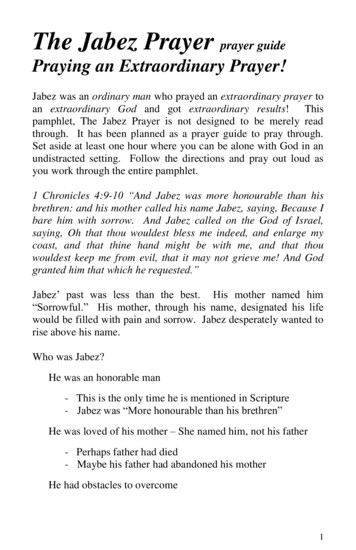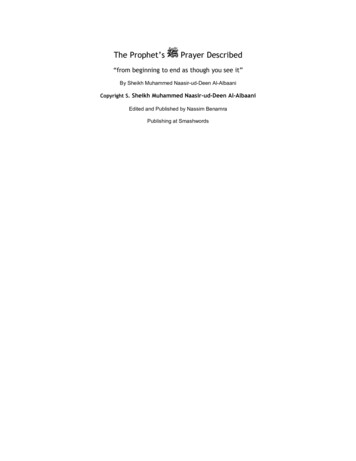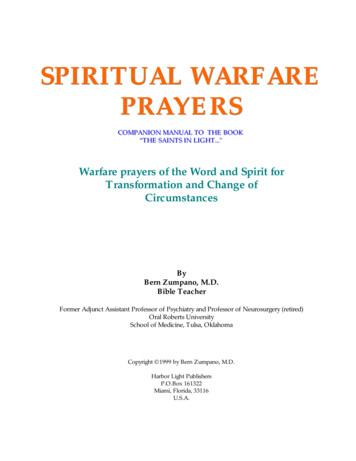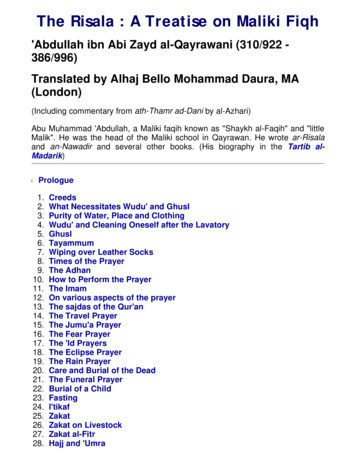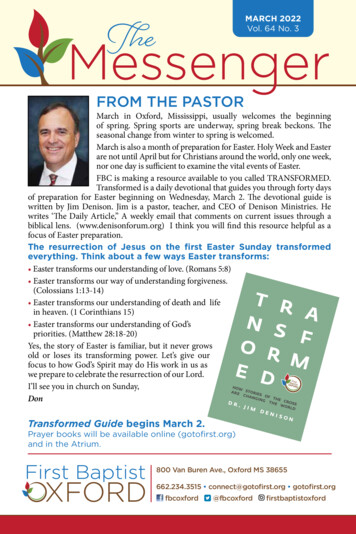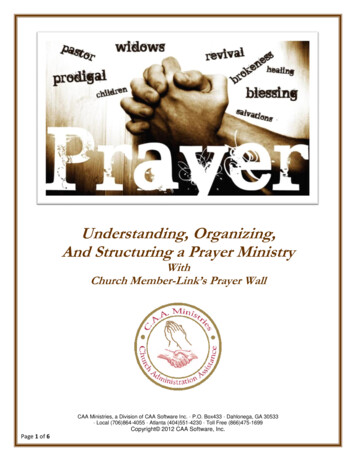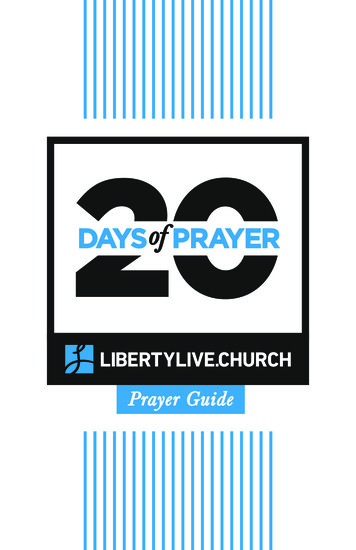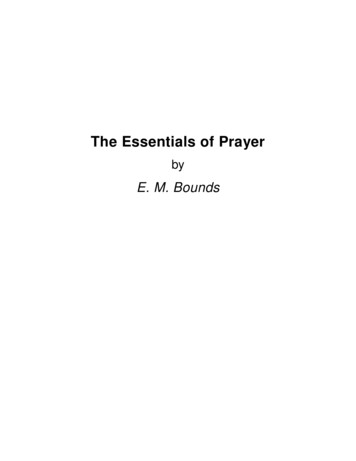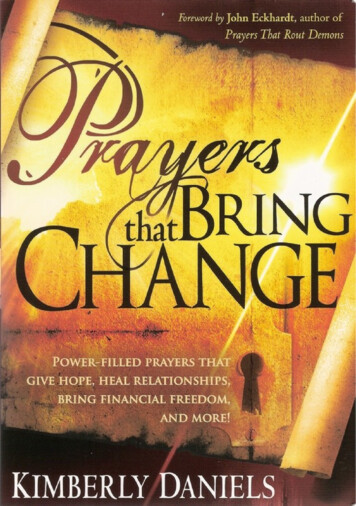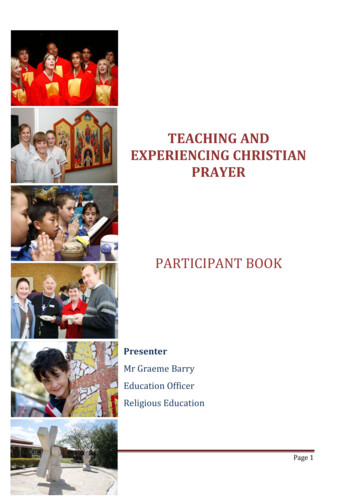
Transcription
TEACHING ANDEXPERIENCING CHRISTIANPRAYERPARTICIPANT BOOKPresenterMr Graeme BarryEducation OfficerReligious Education[Type text]Page 1
Teaching and Experiencing Christian PrayerPage 2
Christian PrayerPrayer and Worship Examples pageTeaching and Experiencing Christian PrayerPage 3
PART ONECHALLENGES AND ISSUES IN TEACHING AND EXPRESSINGCHRISTIAN PRAYERPrior understanding of prayer and praying ‘talking to God’‘raising the mind and heart’ (i.e. the whole person turns to God, focuses on God)‘prayer is a relationship between ourselves and God ‘‘prayer involves both our work and God’s work’Drawing on the richness and diversity of the Christian prayer tradition Vocal prayer, meditation, contemplative prayer as main expressions of prayer (CCC) The richness and the diversity of the Catholic Christian prayer tradition includeso traditional prayers (e.g. Our Father, Hail Mary, Nicene Creed)o formal and informal prayers ( praise, thanksgiving, petition, sorrow)o meditation ( imagery, story, scripture, nature, art)o contemplative prayer ( silence, mantras, breathing)o other methods of prayer ( movement, journal writing, music)Some challenges in teaching and expressing Christian prayer staff and student background can mean a low knowledge basethis can be put in the ‘too hard basket’putting students and teachers in contact with the tradition is however importanttraditional prayer formulas are important for communal prayer and worshipthere is great richness to be unpacked in many traditional prayerschallenge of ‘teaching about’ and ‘teaching to pray’ traditional prayersusing four resources model ‘code breaker’; ‘meaning maker’; ‘text user’; ‘text analyst’memorising traditional prayersexpressing traditional prayers and devotions in contemporary waysteaching and using traditional prayers in a balanced prayer programusing traditional prayers with both staff and studentsconnecting with the extended familyTeaching and Experiencing Christian PrayerPage 4
ACTIVITY ONETraditionalprayers suchas:Our FatherHail MaryGlory BeDaily Onceor Twice aterm yearReview Your Current PracticeWeeklyFortnightlyMonthlyOnce orTwice atermOnce ortwice ayearNeverNicene CreedApostles’ CreedThe RosaryMemorareMagnificatHail Holy QueenThe ConfiteorAct of ContritionThe AngelusMorning prayerEnd of the dayprayerPrayer beforemealsPrayer after mealsFormal andinformal prayerssuch as:Prayers ofthanksgivingPrayers of praisePrayers of petitionPrayers of sorrowSpontaneousprayerBlessing prayersMeditation using:Guided rayer such as:MantrasBreath prayerOther methods ofprayer through:MovementJournal writingMusic / songWhat challenges does this review raise for Christian prayer in our classrooms/school?Teaching and Experiencing Christian PrayerPage 5
PART TWOSOME APPROACHES TO TEACHING CHRISTIAN PRAYER(See Appendices One, Two, Three for background information on commonChristian prayers and devotions)1. Applying the Four Resources Model to Teaching Christian PrayerCode breaker How do I crack this text? How does it work? Is there more than onesemiotic systemoperating here? If so,how do they relate? What are its (their)codes and conventions? How do the parts relatesingularly and incombination?Meaning maker How are the ideas in thistext sequenced – do theyconnect with oneanother? Is the text linear or nonlinear, interactive ornon-interactive? Howdoes this affect the way Imake meaning? What prior knowledgeand experiences mighthelp me make meaningof this text? How will my purpose forreading, and the contextin which I am reading,influence my meaningmaking? Are there other possiblemeanings and readingsof this text?Decoding and encoding the codes and symbols of written, spoken, visual and auditory texts –for example: Using appropriate religious terminology – e.g. ways of addressing God, Jesus in prayer, terminologyassociated with beginning and concluding prayer, vocabulary characteristic of particular forms ofprayer such as petition, praise, thanksgiving, adoration Using voice and body language in religious contexts – e.g. making the sign of the cross, praying,proclaiming the Word, meditation, reciting a decade of the rosary, making the Stations of the Cross Recognising symbolic representations of religious concepts – e.g. the crucifix, a set of rosary beads,icons and pictures and statues of Mary and the Saints as focus for prayer, sign of the Cross, elevationof the monstrance at Benediction Recognising artistic representations of religious ideas – e.g. cloth, colours, artifacts, pictures,statues , objects of piety such as scapulars, medals honouring Mary and the Saints Spelling technical vocabulary – e.g. Rosary, Prayers of Intercession, Pilgrimages Recognising text types and generic structures – e.g. prayer forms, ritual structures, response forms,structures of meditative prayer, structure of litaniesComprehending and composing written, spoken and visual texts – for example: Describing distinguishing characteristics person, event, concept associated with prayer anddevotions in religious texts – e.g. prayers to the Blessed Virgin Mary, prayers associated with aSaint, the Stations of the Cross Interpreting imaginative relationships through imagery – e.g. thy will be done on earth as it is inheaven, Interpreting textual features that indicate personal opinions about issues – e.g. .the concepts,vocabulary and imagery of traditional hymns and prayers, the religious icons, visual art works andmusic used to support the prayer and devotional life of the school, the elements of the prayer ritualsused to celebrate events such as Founders days, Patronal feast days, and liturgical seasons such asLent, Holy Week and Easter. imagery Jesus in religious art, online debates issues related to prayerin the school Narrating real or imagined events in logical sequence attending to the main elements of storyline– e.g. scripting a play based on the Stations of the Cross, creating a series of freeze frames related toa mystery of the Rosary Interpreting technical terminology – e.g. contemplation, meditation, petition, blessing, LectioDivina, mantra, Interpreting ‘cause and effect’ relationships in explanations of issues – e.g. the impact of silenceand stillness on personal health and well being Sequencing actions and activities in prayer rituals – e.g. ANZAC Day prayer ritual, assembly prayerritual, prayerful class celebration of a birthday Selecting, summarising and organising ideas and information from a variety of sources includingvideos, slides, newspapers, books, magazines, multimedia and the internet - e.g. the ritual of theStations of the Cross in various contexts; devotional practices associated with shrines of Mary such asLourdes and Fatima; texts dealing with diverse prayer styles both visual and prose texts Describing the behaviour and feelings of those engaged in a devotional practice or prayer ritual –e.g. participants in a graduation ritual; participants in a classroom prayer experience; participantsin a Marian devotion in the school or parish Retrieving and interpreting information from drawings, tables, graphs, maps and charts – e.g.maps of places associated with particular prayer and devotional traditions such as those associatedwith particular religious orders;, tables of responses to surveys on issues related to how to improvethe prayer experiences offered to students, teachers and parents in the school community Interpreting comparisons and contrast of aspects of places, times, systems and cultures – e.g. thehistorical sources and development of the Rosary devotion, the cultural context and historicalbackground of prayers and devotions related to Mary, to Jesus, to Saints or to particular religioustraditions and spiritual movementsTeaching and Experiencing Christian PrayerPage 6
Interpreting text features within religious text types – e.g. metaphors and similes in kingdomparables, use of imagery in scriptural texts, characteristics of Jesus in religious art Interpreting literal and inferential meanings in gestures, movements, images, sounds and wordsassociated with traditional prayers and devotions, including subtext and metaphor – e.g. gesturesand movements in a prayer ritual, the effect of music used in prayer rituals or devotional practices,the effect of icons and images used as a prayer focus Recognising various personal purposes and contexts for engaging with texts related to traditionalprayer and devotions – e.g. to praise, to bless, to thank, to express sorrow, to ask a favour of God or aSaint, to be still, to be silent, to stimulate imagination, to relate to othersText user What is the purpose ofthis text, and what is mypurpose in using it? How have the users ofthis text shaped itscomposition? What should I do withthis text in this context? What will others do withthis text? What are my options oralternatives afterreading?Understanding the purposes of different written, spoken and visual texts, and using texts indifferent ways for different cultural and social functions – for example: Constructing timelines, story maps, semantic webs or flow charts to represent events or theorganisation of information in printed and visual texts related to prayers and devotions - e.g. thehistory of the development of the Rosary devotion, semantic web of key principles and concepts indesigning a prayer ritual, flow chart to illustrate the structure of the decades of the rosary Using narratives for a variety of purposes - e.g. to produce an account of the life of a particularsaint associated with a particular prayer such as St Francis of Assisi,, connecting healing stories inthe Gospels to contemporary class ritual of forgiveness, connecting scriptural texts in the passionnarratives with scenes in the Stations of the Cross devotion Using procedures with interrelated steps or instructions for a variety of purposes - e.g. preparinginstructions for those with special roles in a class ritual, sequencing and balancing various elementsin a commissioning service, developing a process for making decisions about the design of a prayerspace in the classroom Using reports with attention to sequence and detail - e.g. producing a group report on a –prayerrelated project such as the design of a prayer ritual to celebrate the Patron Saint of the school , Using expositions to synthesise information and express points of view - e.g. arguing the variousimplications of decisions made when planning a significant prayer ritual such as a prayer ritual tobegin or end a school term, making connections between traditional devotions and aspects ofcontemporary life Using transactions to negotiate relationships and activity - e.g. negotiating interviews with olderparishioners as part of project related to traditional prayers and devotions,, negotiating roles in theproduction of a Passion Play, negotiating with the local parish for the use of its church building for aclass prayer ritual Using explanations to inform, clarify and elaborate - e.g. a presentation on the meaning of sacredobjects in the local church intended to nurture prayer and devotion such as the Stations of the Cross,stained glass windows, pictures or statues of Mary and the Saints, side altars or devotional areaswhere people pray or light a candle for a special intention Using discussions - e.g. the pros and cons of music selected for a prayer ritual, the effectiveness orineffectiveness of some traditional prayers and devotions for people today, ways in which traditionalprayers and devotions can be modified for people today, ways in which religious art and artifacts canenhance traditional prayer and Using recounts - e.g. retelling the story associated with a traditional prayer or devotion in one’s ownwords, giving a short reflection to introduce one of the mysteries of the rosary Using media - e.g. using internet sites to research information about a traditional prayer or devotionsuch as Marian devotions in May and October, Ignatian meditation method, using articles frommedia such as the ‘Catholic Leader’ related to prayer and devotion in the catholic community, use the‘Search’ facility at the ‘Catholic Leader Online’ to research material elated to traditional prayers anddevotions such as Marian devotions ing and Experiencing Christian PrayerPage 7
Text analystUnderstanding how texts differentially position readers, viewers and listeners – for example: What kind of person,with what interests andvalues, produced thistext? What are the origins ofthis text? What is the text trying tomake me believe and do? What beliefs andpositions are dominantin the text? What beliefs are silencedor absent? What do I think aboutthe way this textpresents these ideas, andwhat alternatives arethere? Having criticallyexamined this text, whataction am I going to take? Discussing the various ways that people may be represented, marginalised or silenced withintexts - e.g. the use or non-use of inclusive language in the text of traditional prayers and devotions,the linguistic and visual representation of women and men in traditional prayers and devotions Discussing the cultural and religious meanings of images and symbols in texts associated withtraditional prayers and devotions - e.g. The Immaculate Heart of Mary, the Sacred Heart of Jesus, ,Mary as Mother, the imagery used in traditional prayers, scriptural images drawn upon intraditional prayers and hymns Comparing the political, social, cultural, historical and religious allegiances evident in texts - e.g.the texts of traditional hymns and prayers from the Catholic tradition and from Christian traditionsother than Catholic, advertising material from parish bulletins and catholic publications or websitesinviting participation in pilgrimages and Catholic devotional events associated with Mary, Jesus, theSaints or some historical event Understanding the political, social, cultural, historical and religious influences of texts - e.g. therecitation of the Creeds, praying of Grace before and after meals, praying the rosary Analysing divergent interpretations of the same material presented in different media - e.g.interpretations of the passion and death of Jesus in movies, in the devotion of the Stations of theCross,, in visual art, in hymns, in prayersPresenting variant or alternative positions to those of the text - e.g. adapting the Stations of the Crossor the Rosary to address justice issues in contemporary society2. Using prayer related activities from RE ModulesRE QuickFindSearch ‘Prayer and Liturgy’Contexts for PrayerHistorical DevelopmentsLiturgical Seasons and CelebrationsLiturgy of the EucharistLiturgy of the HoursLiturgy of the WordPrayer in World ReligionsPrayer TimesPurposesResourcesSocial and Cultural InfluencesTeaching and Experiencing Christian PrayerPage 8
StructuresStations of the CrossTraditional PrayersTypesSearch ‘Ritual’Crisis RitesPurposesResourcesRites of PassageRoles and ResponsibilitiesSeasonal/Calendrical RitualsSocial and Cultural InfluencesStructuresTeaching and Experiencing Christian PrayerPage 9
ACTIVITY TWOTeaching Prayers and Devotions Using the Four ResourcesModel Join a focus group as under:Early Years P-3Middle Primary 4-5Upper Primary 6-7 Select a prayer or devotion from APPENDIX TWO Fact File ofTraditional Christian Prayers and Devotions Use the charts Applying the Four Resources Model to Teaching Christian Prayer for each individual in the group to write as many effectivestrategies as he/she can you can for teaching your selected prayer or devotionto students in the schooling years covered by your focus groupShare your strategies with others in your focus groupBe prepared to share your strategies with your colleagues from other focusgroupsTeaching and Experiencing Christian PrayerPage 10
PART THREEASSISTING STUDENTS TO DEVELOP AND USE CHRISTIAN PRAYERFORMS FOR CLASSROOM AND SCHOOL USETeaching and Experiencing Christian PrayerPage 11
Daily Prayer of the ChurchTeaching and Experiencing Christian PrayerPage 12
Teaching and Experiencing Christian PrayerPage 13
Antiphonal PrayersAntiphonal Prayers are responses either spoken or sung or chanted. They are commonly found in theliturgy e.g. the response to the Penitential Rite( Lord have mercy, Christ have mercy) , the ResponsorialPsalm ( Be with me Lord when I am in trouble)and the Prayers of General Intercession ( Lord hear ourprayer). Another place where we encounter antiphonal prayer or responses is in the Church’s traditionalprayer of the Litany (pray for us).Antiphonal Prayers can be used when praying with Scripture to facilitate the breaking open of the Wordand lead to more active participation of all involved. This type of Scripture prayer works particularly wellwith students in class prayer, whole school prayer rituals and in liturgical celebrations. This participatorytext will hopefully engage young people more intimately with the text.Key Dimensions to Antiphonal Prayer are: It is a communal prayerIt calls for a deeper involvement in the prayer and invites more active participation from thepray-ers.It keeps the group focused and leads to a highlighting of a specific message. It gives more variety in our responses Antiphons can also be used in life centred prayers arising from the needs of people e.g.Prayers for rain – Response:Sorry prayers – Response: God we ask your forgiveness.Good times –Response: Lord we thank you and praise you.Times of unrest – Response: In unity, we pray for peace in our world.Teaching and Experiencing Christian PrayerPage 14
How to write Antiphonal prayers: Choose a theme e.g. victims of droughtDecide on an appropriate response e.g. Lord send us rainThis response could be displayed on PowerPoint or onlarge cardWrite the petitions. Invite students to write prayers ofpetition. Pray the prayersExample of an Antiphonal PrayerRESPONSE: LORD SEND US RAIN.We pray to God for the gift of rain .Lord send us rainWe pray to God for all the men and women who grow crops and care for animals that produce food .Lordsend us rainWe pray to God for all children who live in drought areas who may not have basic needs being met at thistime . Lord send us rainWe pray for all who suffer depression and anxiety because they have lost hope Lord send us rainWe pray for ourselves that we might have a compassionate heart towards the people in the drought areasand the generosity to support any efforts to support them Lord send us rainWe pray for the animals that suffer and die in drought conditions . Lord send us rain.We pray for the dry land that it may soon receive life giving rain . Lord send us rainTeaching and Experiencing Christian PrayerPage 15
How to write Antiphonal prayers using Scripture:1. Read the scripture passage2. Select key messages and key words3. Break the passage at appropriate places4. Insert the response into this break5. Use visuals to prompt responsesExample of Antiphonal Prayer using the PsalmsPsalm 20 (an adaption)RESPONSE: GOD IS WITH USMay God answer us in times of trouble. May the name of God protect us . God is with usMay God send us help and give us support . God is with usMay God we know that God walks with us. May we know that God answers our prayers . God iswith usMay we praise God’s name. May we know God as our God . God is with usTeaching and Experiencing Christian PrayerPage 16
Example of using Antiphonal Scripture with Early YearsBased on Luke 2.The students respond with the echo and actions.Readers A and BA: When Jesus was 12 years old, Mary and Josephtook him to the temple for a special ceremony.B:The holy templeA:The temple was in Jerusalem and they had totravel there by walking.Echo ResponseStudents: The holy templeStudents: Lots of walking!B:Lots of walking!A: There were many people in Jerusalem. It wascrowded. B:Lots of people!A: When it was time to go home, Jesus stayed inJerusalem.Students: Lots of people!Students: JerusalemB:JerusalemA: Mary and Joseph thought he was with his friends. Students: Very worried!That night they looked for him. When they couldnot find him they were worried.B:Very worried!A: Jesus was lost!B: Oh!!!!!Students: Oh!!!!!A:For three days Mary and Joseph looked for Jesus. Students: Looked everywhereB: Looked everywhereA:At last they found him in the temple.Students: The holy templeA: Jesus was listening to the wise teachers andasking them questions.Students: Questions?B:The holy templeB: Questions?Teaching and Experiencing Christian PrayerPage 17
A: Mary said, “We have been very worried aboutyou.”Students: Very worried!A: Jesus said that he had been talking to theteachers about GodStudents: God his fatherB: Very worried!B: God his fatherA:Jesus went home with Mary and Joseph and did as Students: Wise and strong!he was told. God blessed Jesus and he grew wiseand strong.B: Wise and strong!Teaching and Experiencing Christian PrayerPage 18
Example of using Antiphonal Scripture with older studentsBased on John 8:12, 10:27, 12:26 and 1Peter 2:20b-21Reader 1: These words are adapted from the Gospel of John.Reader 2: Jesus spoke to his followers saying:Reader 1: I am the light of the worlds and anyone who follows me will never again walk in the dark.Reader 2: Rather they will have the light of life.All: Come follow meReader 1: My sheep hear my voice;I know who they are,And they follow me.Reader 2: Whoever serves me must follow me,and wherever I am, my servant will be there as well.All: Come follow me.Reader 1: And these words are adapted from the First letter of Peter.Reader 2: If you endure and suffer when you do right, you will have God’s approval.Reader 1: This is why we have been calledbecause Christ has also suffered for us.Reader 2: Christ leaves us an example, so weTeaching and Experiencing Christian PrayerPage 19
may follow in his steps.All: Come follow me.Reader 1: These words are from God and the servants of God.All: We give thanks to God for the gift of this Word.May we follow Christ and deepen our call to faith.( taken from A Time to Pray with the New Testament David Haas GIA Publications Chicago ISBN: 157999-531-4)Teaching and Experiencing Christian PrayerPage 20
BlessingsBlessing Prayers:A blessing prayer is one that calls on God’s power to care for a person, place, thing or undertaking.In praying a prayer of blessing, we ask for God’s presence, goodness and protection to be evidentin the lives of those the prayer is intended for or those who will enter the place that is beingblessed e.g. a school, church, classrooms, libraryThere are many opportunities to use blessing prayers. It is a matter of recognising opportunities to usethem. It is also important to teach about them so that students are familiar with the process and come to asense of feeling comfortable in blessing situations.Blessing prayers can be prayed: at the start of a new school yearat the end of the daybefore a trip or pilgrimage or service learning activityon a birthday or anniversarybefore a retreat or campfor school student leadersto welcome new studentsto farewell teachers and/or studentsfor the school holidaysfor a sports eventfor students preparing to celebrate a sacramentfor fathers, mothers, grandparents, familiesA blessing prayer is always included at the end of a mass and may also be included in other liturgicalcelebrations. They can also be used in the context of prayer assemblies and in the classroom.How to teach about blessings Explore the greeting used in the school e.g. May God bless you; Peace be with you. What does thismean? Why do we say it? What should we be thinking and feeling when we use this greeting?Invite students to name times that they may have experienced a blessing from someone else e.g.at baptism, confirmation, mass, liturgical celebration, class or school ritual.Discuss with students about times that they bless themselves e.g. making the sign of the Cross,using holy water, tracing the cross on their foreheads, lips and hearts before listening to thegospel.Encourage students to name when they have been involved in giving someone a blessing e.g. afarewell ritual, a birthday blessing, a blessing for a new student, blessing of student leaders,blessing of people going on a pilgrimage e.g. WYDExplore plaques or foundation stones in the school environment.Discuss the concepts in blessing prayers at the end of a mass.Explore blessings from Scripture: leaders often blessed people, especially when getting ready toleave them e.g. Moses (Deut 33; Joshua (22:6-7); and Jesus (Luke:24:50). The First Letter fromPeter 1:3-9 has several elements of a blessing prayer beginning with giving thanks and praise toGod.Learn Blessing songs which can be used at school and liturgical celebrations.Involve the students in writing blessing prayers for specific occasions. Use the structure of You,Who, Do, Through.Teaching and Experiencing Christian PrayerPage 21
How to pray a blessingThere are many ways to pray a blessing, including having all those doing the blessing raise their handover the person or group to be blessed. A blessing might also involve placing a hand on the person’sshoulder or head.How to write a blessingUsing the You Who Do Through structureYOU- begin by addressing God or naming God. e.g. God of new beginnings .WHO- name ‘WHO’ God is for us, e.g. You are our strength and hopeDO- we ask God to bless, to ‘DO’ something e.g. Be with us as we journey together this year.THROUGH - We pray to God in and THROUGH Christ, so our prayer concludes with a simple ThroughChrist our Lord AmenExamples of BlessingsBlessing for a BirthdayLoving God, you are with us in all we do.Bless as he/she celebrates his/her birthday.May he/she be blessed with blessed with peace & joy.May he/she continue to grow in your love.We make this prayer through Jesus, our loving friend.Amen.Blessing for Mother’s/Father’s DayGod of gentleness, you look after us and never stop loving us.Bless our mum/dad.May she/he know that I/we love her and that I/we appreciate all she does for me/us.May she/he know she/he is precious in the eyes of our God.Amen.Blessing for School Student LeadersSpirit of God, you guide us and light our way.Bless our Year six/eleven students as they take on the role as leaders of our school/campus/college.Bless our community as we encourage and support them in their leadership role.We make this prayer through Christ our Lord. Amen.Teaching and Experiencing Christian PrayerPage 22
Blessing for a school camp/retreatGod our guiding light, you are protector of us allBless us as we experience new things on camp.Bless us all as we enjoy our time together and keep us safe.We make this prayer through Jesus, our loving friend. AmenBlessing to welcome a new studentLoving God, you love and care for us all.Bless (name) as he/she begins his/her journey with us.Bless us all as we welcome him/her to our class community.We make this prayer through Jesus your Son. AmenBlessing for a Sports EventGod of creation, you inspire us and protect us.Bless our class/school and help us to have fun at the athletics/swimming/sport carnival.We make this prayer through Jesus our brother. AmenSimple and short blessings to end a prayer ritual, liturgy or the day:May our God of Hope fill us with joy. AmenMay the peace of Christ guide our way. AmenMay the spirit of wisdom inform our thoughts. AmenMay God’s word live in our hearts. AmenMay God keep us from all harm. AmenMay God’s wisdom guide us. AmenMay God’s tender hand support us. AmenMay God’s love surround us. AmenMay almighty God bless us in the name of the Father and of the Son and of the Holy Spirit. AmenTeaching and Experiencing Christian PrayerPage 23
IntercessionsIntercessions are prayers of petition – that is, we are asking God for something. Intercessions may takethe form of a litany. Intercessions need to be short and simple, placing our needs before an all loving God.They are offered by the whole assembly and are meant to intercede for the needs of the church and theworld.A time of Silence follows the statement of the prayer intention so that the “faithful” can pray. The use ofa pause is very important in the intercessions. The reader announces the intention and then pauses(count to 5 in your head). General Intercessions are to bear relation to what is currently happening in thecommunity and the world. Intercessions can be prayed in the context of classroom or school prayerassemblies.If they are written to be used in the context of liturgy, the General Instruction of the Roman Missal statesthat the petitions should be offered for the Church civil authorities and the salvation of the world thoseoppressed by any needs the local community.A good classroom strategy would be to gather to discuss or plan the intercessions before you actuallypray, remembering the choice of formats and what may be current and local needs. Stimulus could comefrom current affairs as in images from newspapers. A class list titled “We Pray for .” can be added to assituations and needs arise. Structure for Prayers of IntercessionInvitation to prayer: a brief invitation to pray e.g. Trusting in God’s mercy, let us pray.Intentions or Prayers of IntercessionSilenceResponseLord hear usLord hear our prayerConcluding prayer: e.g. We make these prayersthrough Christ our Lord Amen.Example of Prayers of Intercession Invitation to prayer:Trusting that our God is near, let us pray for the needs of the world. Prayers of intercession:1. For all members of the church throughout the world .SilenceLord hear usResponse: Lord hear our prayer2. For all people in our school and families . SilenceLord hear usResponse: Lord hear our prayerTeaching and Experiencing Christian PrayerPage 24
3. For the care and protection of God’s world . SilenceLord hear usResponse: Lord hear our prayer4. For peace in our
‘prayer is a relationship between ourselves and God ‘ . Decoding and encoding the codes and symbols of written, spoken, visual and auditory texts – . connecting healing stories in the Gospels to contemporary class ritual o
